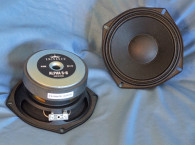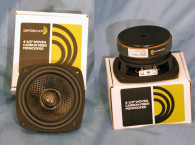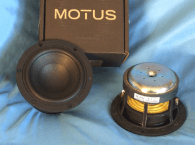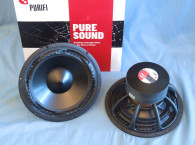
In Latin, Motus is the past perfect participle of moveo, which means “I move.” In practice, the word connotes movement, inspiration, and passion, so you get the idea.” Motus drivers are built in China, which is starting to be more common in the high-end arena, with companies such as Revel, Monitor Audio, and Sonus Faber sourcing components out of China and Indonesia. Voice Coil printed its first review of a Motus product, the Motus UH25CTI dome tweeter, in the December 2012 issue. This month, Motus sent the interesting Motus 8” midbass driver, the UH205P1.
The Motus UH205PI’s feature set pretty much reads like the feature set of several other high-end mid-bass woofers. Starting with the frame, Motus used a really nicely configured six-spoke cast-aluminum frame with narrow 11-mm wide spokes to minimize reflections back into the cone. The area below the suspended spider mounting shelf is almost completely open, resulting in effective cooling of the motor and the voice coil. For the cone assembly, Motus chose a rather stiff curvilinear profile pressed paper cone with a fairly large (reinforcing almost at the midpoint of the cone) 3.125” diameter concave pressed paper dust cap. Compliance is provided by a nitrile-butadiene rubber (NBR) surround, designed with a shallow discontinuity where it attaches to the cone edge. Remaining compliance comes from a 5.5” diameter flat cloth spider.
The Motus UH205PW1’s finite element analysis (FEA) optimized motor design is well thought out and incorporates a ferrite ring magnet, a machined undercut pole piece, and dual copper shorting rings (Faraday shields). As with the Scan-Speak’s Illuminator woofer, the Motus UH205PW1 has an underhung design with an 8.5 mm winding height in a 25 mm gap. This drives a 2.4” (60.4 mm) diameter four-layer voice coil wound with round copper wire on a non-conducting Kapton former. Motor parts above and below the 142 mm × 25 mm magnet are machined and polished. Additional cooling is provided by an 18 mm diameter rear pole vent plus six 6 mm diameter peripheral vents. Last, the voice coil is terminated to a pair of gold-plated terminals, appropriately located on opposite sides of the frame. In terms of the UH205PW1’s overall physical appearance, this is a really good looking driver (see Photo 1).
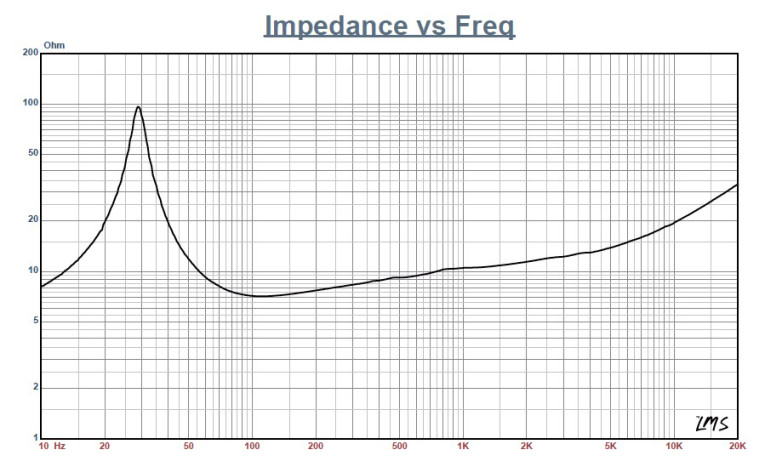
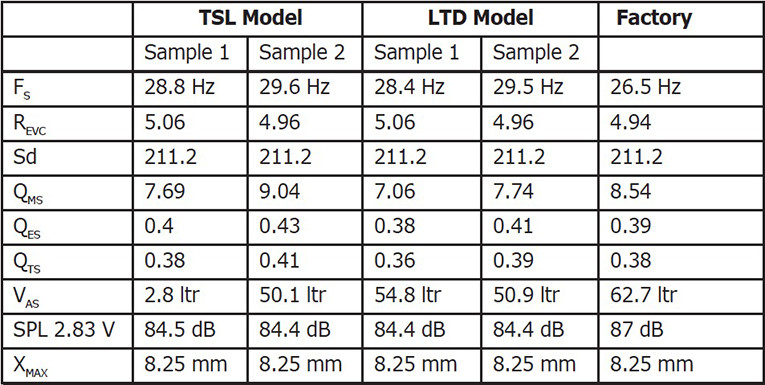
I began analysis of the UH205PW1 using the LinearX LMS analyzer and VIBox to create voltage and admittance (current) curves. The driver was clamped to a rigid test fixture in free air at 0.3, 1, 3, 6, 10, 15, 20, and 25 V. As with almost all 8” diameter woofers, 20 to 25 V curves are usually too nonlinear for LEAP to get a reasonable curve fit and usually have to be discarded. However, due to the UH205PW1’s linearity and high XMAX, I was able to use all the curves including the 25 V curves.
As per the established Test Bench measurement protocol, the LMS oscillator is turned on for a progressively increasing time period between sweeps to keep the driver heated as close to the third thermal time constant as possible (from 10 to 50 seconds between sweeps, depending on the voltage level).
As another aspect of the Test Bench test protocol, I no longer use a single added mass measurement to determine VAS. Instead, I use the actual measured cone assembly mass (Mmd) supplied by the driver manufacturer, which was 34.79 grams for the UH205PW1. Next, I post-processed the 18 550-point stepped sine wave sweeps for each UH205PW1 sample and divided the voltage curves by the current curves (admittance) to derive impedance curves, added phase by the LMS calculation method, and imported them to the LEAP 5 Enclosure Shop software along with the accompanying voltage curves.
I selected the complete data set, the multiple voltage impedance curves for the LTD model, and the 1 V impedance curve for the TSL model in the transducer derivation menu in LEAP 5 and created the parameters for the computer box simulations. Figure 1 shows the 1 V free-air impedance curve. Table 1 compares the LEAP 5 LTD, TSL, and factory published parameters for both of the Motus UH205PW1 samples.
The UH205PW1’s LEAP parameter calculation results were close to the published factory data. As usual, I followed my normal protocol and set up computer enclosure simulations using the LEAP LTD parameters for Sample 1. Two computer box simulations were programmed into LEAP 5—one Butterworth sealed enclosure with a 0.54-ft3 volume and 50% fiberglass damping material and one QB3 vented enclosure with a 0.84-ft3 volume tuned to 32 Hz with 15% fiberglass fill material.
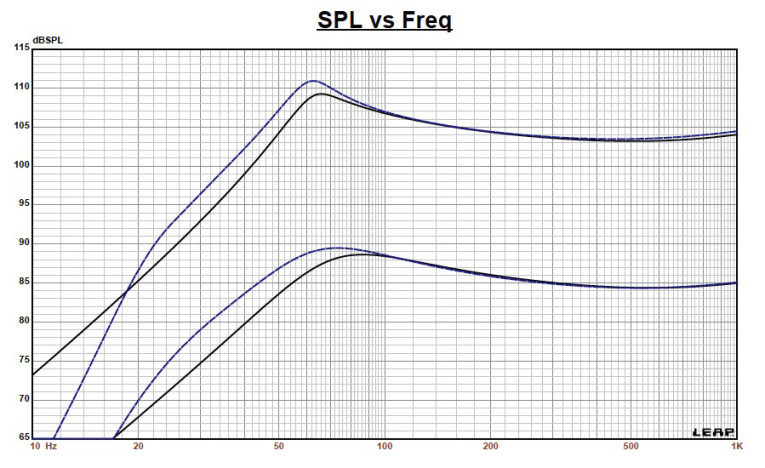


Figure 2 displays the UH250PW1’s results in the sealed and the vented boxes at 2.83 V and at a voltage level high enough to increase cone excursion to 9.5 mm (XMAX + 15%). This produced a –3 dB = 57 Hz (F6 = 47 Hz) with a QTC = 0.7 for the sealed box, and for the QB3 vented enclosure a F3 frequency of 48.5 Hz (F6 = 39.4 Hz). Increasing the voltage input to the simulations until the maximum linear cone excursion was reached resulted in 109 dB at 34 V for the sealed enclosure simulation and 111 dB for a 37 V input level for the larger vented box.
Figure 3 shows the 2.83 V group delay curves. Figure 4 shows the 34/37 V excursion curves. Note that because the vented box example reached maximum excursion at about 24 Hz, a steep 24 dB/octave high-pass active filter located at about 20 to 25 Hz would increase the power handling and output the vented box example.

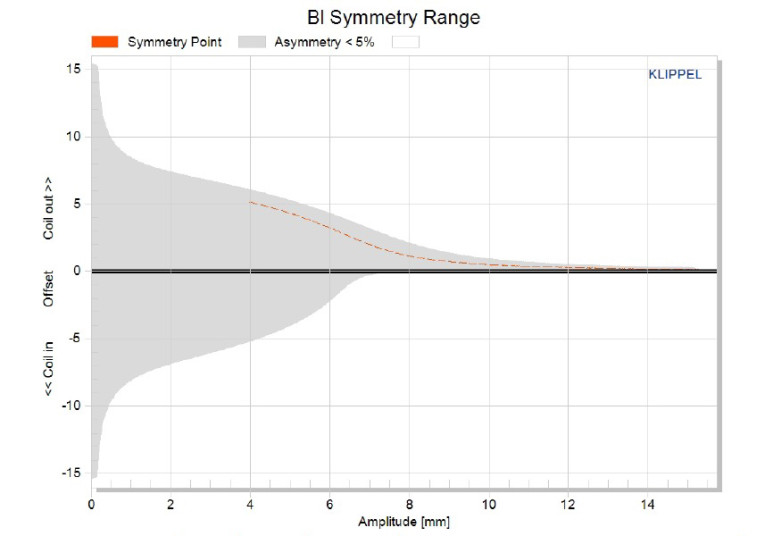

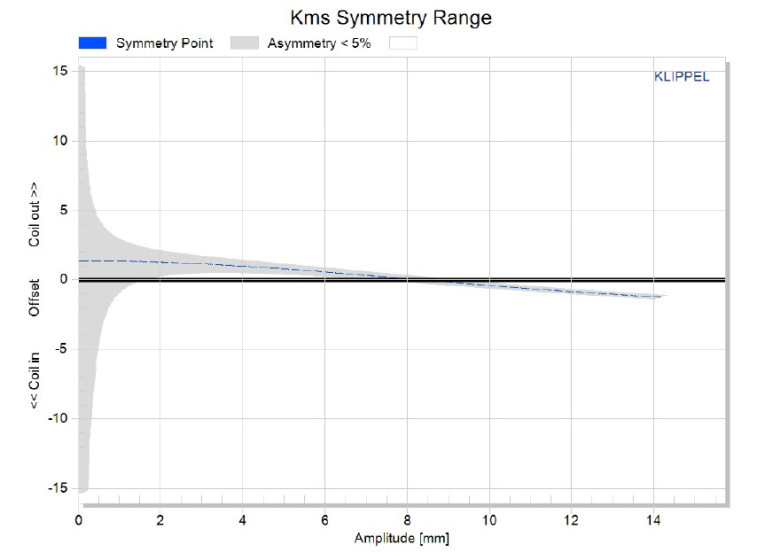
Klippel analysis for the UH250PW1 produced the Bl(X), KMS(X) and Bl and KMS symmetry range plots shown in Figures 5–8. (Our analyzer is provided courtesy of Klippel GmbH and Patrick Turnmire of Redrock Acoustics performed the analysis.) This data is extremely valuable for transducer engineering, so if you don’t own a Klippel analyzer and would like to have analysis done on a particular project, visit www.redrockacoustics.com.
The UH250PW1’s Bl(X) curve, shown in Figure 5, is reasonably symmetrical and quite broad for an 8” woofer. The Bl symmetry plot, shown in Figure 6), has a substantial amount coil-out offset at 4 mm of excursion, but that is in a region of uncertainty for the analyzer. At the UH250PW1’s physical XMAX (8.25 mm), there is a trivial 0.015 mm coil-out offset, and this is in a region of much higher certainty.
Figure 7 shows the KMS(X) curve, which was not as symmetrical in both directions as the Bl curve. However, the KMS symmetry range, shown in Figure 8, only has a small coil-out offset at the rest position (1.4 mm), which decreases to totally trivial coil-out offset of 0.03 mm at the driver’s physical XMAX.
Displacement limiting numbers calculated by the Klippel analyzer for the UN205PW1 were XBl at 82% Bl = 11.6 mm and for the XC at 75% CMS minimum was 6.8 mm, which means that for this Motus midwoofer, the compliance is the most limiting factor for prescribed distortion level of 10%. If we use a less conservative 20% distortion criteria of Bl falling to 70% of its maximum value and compliance falling to 50% of its maximum value, the numbers would be XBl = 13.2 mm and XC = 10.7, both numbers being greater than the driver’s physical 8.25 mm XMAX.
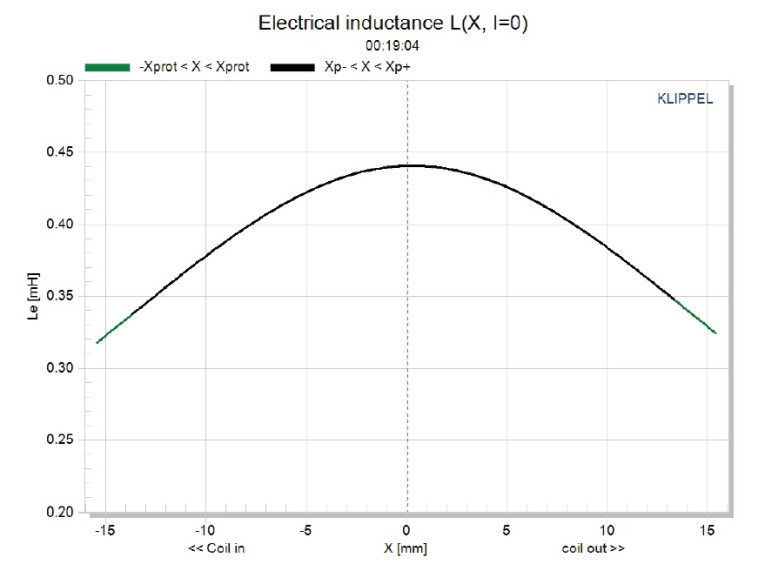
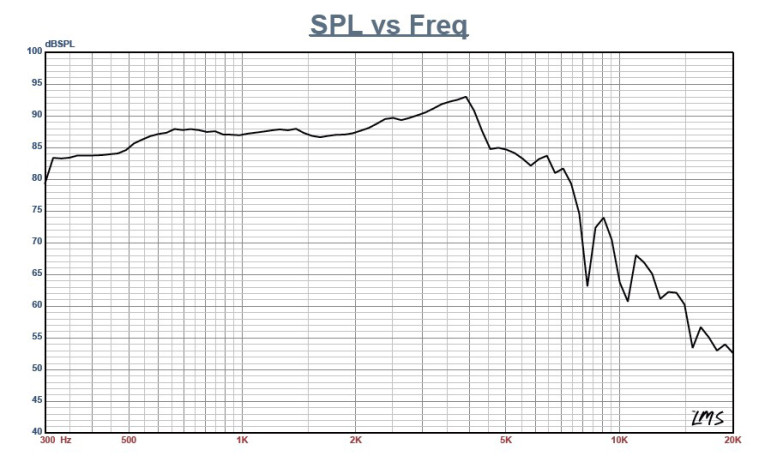
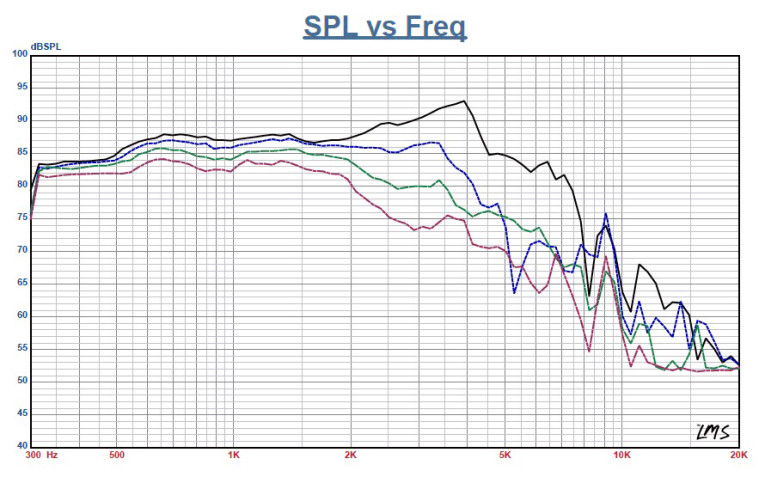

Figure 9 gives the UH250PW1’s inductance curves Le(X). Inductance will typically increase in the rear direction from the zero rest position as the voice coil covers more pole area. However, inductance does not occur because of the effective multiple copper inductive shorting rings. The result is a fairly minor inductance swing with inductive variation of only 0.04 mH from the resting position to the XMAXIN and XMAXOUT positions, which is good performance.
With the Klippel testing completed, I mounted the UN205PW1 in an enclosure that had an 18” × 9” baffle filled with damping material (foam). Next, I measured the device under test on and off axis from a 300 Hz to 40 kHz frequency response at 2.83 V/1 m, using the LinearX LMS analyzer set to a 100-point gated sine wave sweep. Figure 10 shows the UH250PW1’s on-axis response, indicating a smoothly rising response to about 4 kHz, where it begins is low-pass roll-off.
Figure 11 displays the on- and off-axis frequency response at 0°, 15°, 30°, and 45°. The –3 dB frequency at 30° off axis relative to the on-axis SPL is about 1.9 kHz, suggesting a crossover around 2 kHz should be appropriate. And finally, Figure 12 gives the UH250PW1’s two-sample SPL comparisons, showing a close match throughout the operating range up to 4 kHz.
Then, I used the Listen SoundCheck software, the AmpConnext analyzer, and the SCM microphone to measure distortion and generate time-frequency plots. For the distortion measurement, I rigidly mounted the UH250PW1 in free air and set the SPL to 94 dB at 1 m (7 V) using a noise stimulus. Then, I measured the distortion with the Listen microphone placed 10 cm from the dust cap. Figure 13 shows the distortion curves. I used SoundCheck to get a 2.83 V/1 m impulse response and imported the data into Listen’s SoundMap Time/Frequency software. Figure 14 shows the resulting CSD waterfall plot. Figure 15 shows the Wigner-Ville (for its better low-frequency performance) plot.
For more information, visit www.motusaudio.com.
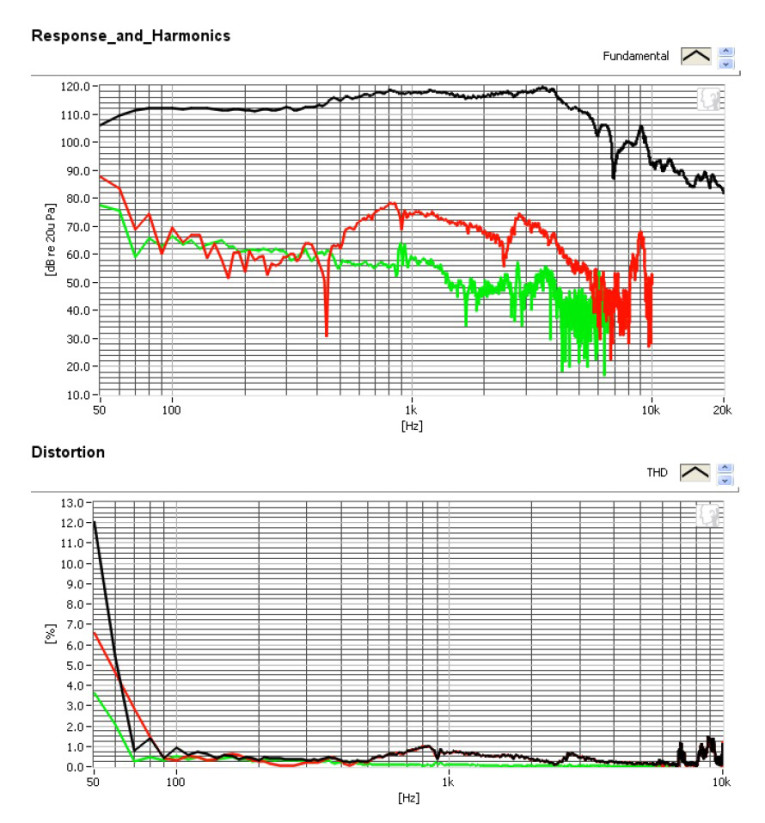

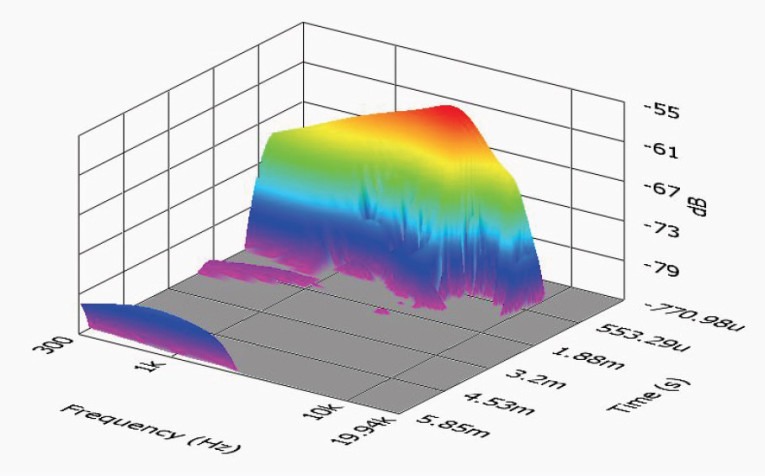
This article was originally published in Voice Coil, November 2015.




